Schemat DSPL
Zadbaj o dobrą organizację dzięki kolekcji
Zapisuj i kategoryzuj treści zgodnie ze swoimi preferencjami.
Ta strona i powiązane z nią podstrony dokumentują schemat XML DSPL.
Ten materiał jest przeznaczony dla zaawansowanych użytkowników, którzy chcą poznać
niskie szczegóły dotyczące języka; dla większości użytkowników treść
w
Przewodnik dla programistów powinien wystarczyć do tworzenia i edytowania
w zbiorach danych DSPL.
Pełny schemat XML jest dostępny do pobrania w formacie XSD
w:
witrynie kodu DSPL.
Element: dspl
| Przestrzeń nazw |
http://schemas.google.com/dspl/2010 |
| Adnotacje |
Specyfikacja DSPL opisuje zbiór danych. Zbiór danych to
które są określane przez
przestrzeń nazw. Zbiór danych składa się z tych elementów:
elementy: – tabele: dane dotyczące pojęć i wycinków zdefiniowanych w
zbiór danych – Pojęcia: definicje i struktury określone przez użytkownika używane w
wycinki: kombinacje wymiarów i danych występujących w
zbiór danych – tematy: hierarchiczne etykiety używane do porządkowania koncepcji
zbiór danych |
| Diagram |
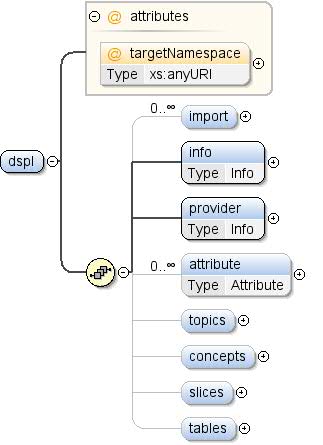 |
| Właściwości |
|
| Model |
import* , info , provider ,
atrybut* , tematy{0,1} , koncepcje{0,1} , wycinki{0,1} , tabele{0,1} |
| Dzieci |
atrybut, koncepcje, import,
info, dostawca, wycinki,
tabele, tematy |
| Instancja |
<dspl targetNamespace="">
<import location="" namespace="">{0,unbounded}</import>
<info>{1,1}</info>
<provider>{1,1}</provider>
<attribute concept="" id="">{0,unbounded}</attribute>
<topics>{0,1}</topics>
<concepts>{0,1}</concepts>
<slices>{0,1}</slices>
<tables>{0,1}</tables>
</dspl>
|
| Atrybuty |
| QName |
Typ |
Naprawiono |
Domyślny |
Użyj |
Adnotacja |
| targetNamespace |
xs:anyURI |
|
|
opcjonalnie |
Każdy zbiór danych może mieć docelową przestrzeń nazw. Wartość docelowa
przestrzeń nazw to identyfikator URI jednoznacznie identyfikujący zbiór danych. Więcej
informacje na temat użycia przestrzeni nazw w kodzie XML znajdziesz tutaj:
http://www.w3.org/TR/REC-xml-names/ Jeśli nie ma docelowego parametru targetNamespace
jeśli zbiór danych zostanie podany, przestrzeń nazw zostanie wygenerowana
zaimportowane dane. |
|
| Źródło |
<xs:element name="dspl">
<xs:annotation>
<xs:documentation>A DSPL specification describes a dataset. A dataset is
identified by its namespace. A dataset is comprised of the
following elements:
- Tables: Data for the concepts and slices defined in the
dataset
- Concepts: User-specified definitions and structures used in
the dataset
- Slices: Combinations of dimensions and metrics present in
the dataset
- Topics: Hierarchical labels used to organise the concepts of
the dataset</xs:documentation>
</xs:annotation>
<xs:complexType>
<xs:sequence>
<xs:element name="import" minOccurs="0" maxOccurs="unbounded">
<xs:annotation>
<xs:documentation>Import directive for external datasets -- modeled after
the XML Schema import directive. In order to use
elements defined in an external dataset, the external
dataset must be referenced using an import directive.</xs:documentation>
</xs:annotation>
<xs:complexType>
<xs:attribute name="namespace" use="required">
<xs:annotation>
<xs:documentation>The namespace of the imported dataset, specified as
a URI. A prefix must be associated with this
namespace before its contents can be referenced. See
[XML Namespaces] for more information about the use
of namespaces and prefixes in XML.</xs:documentation>
</xs:annotation>
</xs:attribute>
<xs:attribute name="location" use="optional">
<xs:annotation>
<xs:documentation>An optional location where the definition of the
imported dataset can be found, specified as a
URL. If the location is omitted, the system
processing this DSPL dataset must already know the
imported dataset.
Implementation note: The Google dataset importer
ignores the location attribute. Any imported dataset
must be known by the Google importer beforehand.</xs:documentation>
</xs:annotation>
</xs:attribute>
</xs:complexType>
</xs:element>
<xs:element name="info" type="Info" minOccurs="1">
<xs:annotation>
<xs:documentation>General information about the dataset.</xs:documentation>
</xs:annotation>
</xs:element>
<xs:element name="provider" type="Info">
<xs:annotation>
<xs:documentation>General information about the dataset provider.</xs:documentation>
</xs:annotation>
</xs:element>
<xs:element name="attribute" type="Attribute" minOccurs="0" maxOccurs="unbounded">
<xs:annotation>
<xs:documentation>Attribute associated with the dataset.</xs:documentation>
</xs:annotation>
</xs:element>
<xs:element name="topics" minOccurs="0">
<xs:annotation>
<xs:documentation>A hierarchy of topics used to organize the contents of
the dataset. The order in which topics are given is
meaningful and should be respected by visualizations
that displays these topics.</xs:documentation>
</xs:annotation>
<xs:complexType>
<xs:sequence>
<xs:element name="topic" type="Topic" maxOccurs="unbounded"/>
</xs:sequence>
</xs:complexType>
</xs:element>
<xs:element name="concepts" minOccurs="0">
<xs:annotation>
<xs:documentation>A list of concepts defined in this dataset.</xs:documentation>
</xs:annotation>
<xs:complexType>
<xs:sequence>
<xs:element name="concept" type="Concept" maxOccurs="unbounded"/>
</xs:sequence>
</xs:complexType>
</xs:element>
<xs:element name="slices" minOccurs="0">
<xs:annotation>
<xs:documentation>A list of slices defined in this dataset.</xs:documentation>
</xs:annotation>
<xs:complexType>
<xs:sequence>
<xs:element name="slice" type="Slice" maxOccurs="unbounded"/>
</xs:sequence>
</xs:complexType>
</xs:element>
<xs:element name="tables" minOccurs="0">
<xs:annotation>
<xs:documentation>A list of tables defined in this dataset.</xs:documentation>
</xs:annotation>
<xs:complexType>
<xs:sequence>
<xs:element name="table" type="Table" maxOccurs="unbounded"/>
</xs:sequence>
</xs:complexType>
</xs:element>
</xs:sequence>
<xs:attribute name="targetNamespace" type="xs:anyURI" use="optional">
<xs:annotation>
<xs:documentation>Each dataset may provide a target namespace. The
target namespace is a URI that uniquely identifies the
dataset. For more information about the use of namespaces in XML,
see:
http://www.w3.org/TR/REC-xml-names/
If no targetNamespace is provided, then a namespace will be
generated when the dataset is imported.</xs:documentation>
</xs:annotation>
</xs:attribute>
</xs:complexType>
</xs:element>
|
Element: dspl / import
| Przestrzeń nazw |
http://schemas.google.com/dspl/2010 |
| Adnotacje |
Dyrektywa importu dla zewnętrznych zbiorów danych – modelowana na podstawie kodu XML
Dyrektywa importu schematu. Aby wykorzystać elementy zdefiniowane w tagu zewnętrznym
zbiór danych, do zewnętrznego zbioru danych trzeba się odwołać za pomocą funkcji importu
|
| Diagram |
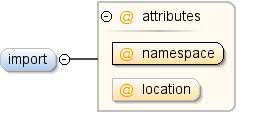 |
| Właściwości |
| treść: |
Złożone |
| min.: |
0 |
| maxOccurs: |
nieograniczony |
|
| Atrybuty |
| QName |
Typ |
Naprawiono |
Domyślny |
Użyj |
Adnotacja |
| lokalizacja |
|
|
|
opcjonalnie |
Opcjonalna lokalizacja, w której definicja zaimportowanego pliku
w postaci adresu URL. Jeśli lokalizacja to
pomijany, system przetwarzający ten zbiór danych DSPL musi już wiedzieć,
zaimportowanego zbioru danych. Uwaga dotycząca implementacji: zbiór danych Google
importujący ignoruje atrybut lokalizacji. Każdy zaimportowany zbiór danych musi
być wcześniej znane importerowi Google. |
| przestrzeń nazw |
|
|
|
wymagane |
Przestrzeń nazw zaimportowanego zbioru danych określona jako
Identyfikator URI. Z tą przestrzenią nazw musi być powiązany prefiks, zanim jej
może się odwoływać. Więcej informacji znajdziesz w sekcji [Przestrzenie nazw XML].
informacje na temat użycia przestrzeni nazw i prefiksów w
XML. |
|
| Źródło |
<xs:element name="import" minOccurs="0" maxOccurs="unbounded">
<xs:annotation>
<xs:documentation>Import directive for external datasets -- modeled after
the XML Schema import directive. In order to use
elements defined in an external dataset, the external
dataset must be referenced using an import directive.</xs:documentation>
</xs:annotation>
<xs:complexType>
<xs:attribute name="namespace" use="required">
<xs:annotation>
<xs:documentation>The namespace of the imported dataset, specified as
a URI. A prefix must be associated with this
namespace before its contents can be referenced. See
[XML Namespaces] for more information about the use
of namespaces and prefixes in XML.</xs:documentation>
</xs:annotation>
</xs:attribute>
<xs:attribute name="location" use="optional">
<xs:annotation>
<xs:documentation>An optional location where the definition of the
imported dataset can be found, specified as a
URL. If the location is omitted, the system
processing this DSPL dataset must already know the
imported dataset.
Implementation note: The Google dataset importer
ignores the location attribute. Any imported dataset
must be known by the Google importer beforehand.</xs:documentation>
</xs:annotation>
</xs:attribute>
</xs:complexType>
</xs:element>
|
Element: dspl / info
| Przestrzeń nazw |
http://schemas.google.com/dspl/2010 |
| Adnotacje |
Ogólne informacje o zbiorze danych. |
| Diagram |
 |
| Typ |
Informacje |
| Właściwości |
|
| Model |
name , description{0,1} , url{0,1} |
| Dzieci |
description, name, url |
| Instancja |
<info>
<name>{1,1}</name>
<description>{0,1}</description>
<url>{0,1}</url>
</info>
|
| Źródło |
<xs:element name="info" type="Info" minOccurs="1">
<xs:annotation>
<xs:documentation>General information about the dataset.</xs:documentation>
</xs:annotation>
</xs:element>
|
Element: dspl / dostawca
| Przestrzeń nazw |
http://schemas.google.com/dspl/2010 |
| Adnotacje |
Ogólne informacje o dostawcy zbioru danych. |
| Diagram |
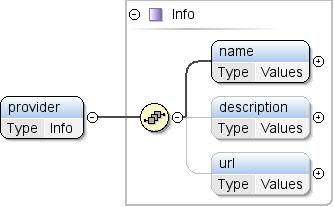 |
| Typ |
Informacje |
| Właściwości |
|
| Model |
name , description{0,1} , url{0,1} |
| Dzieci |
description, name, url |
| Instancja |
<provider>
<name>{1,1}</name>
<description>{0,1}</description>
<url>{0,1}</url>
</provider>
|
| Źródło |
<xs:element name="provider" type="Info">
<xs:annotation>
<xs:documentation>General information about the dataset provider.</xs:documentation>
</xs:annotation>
</xs:element>
|
Element: dspl / atrybut
| Przestrzeń nazw |
http://schemas.google.com/dspl/2010 |
| Adnotacje |
Atrybut powiązany ze zbiorem danych. |
| Diagram |
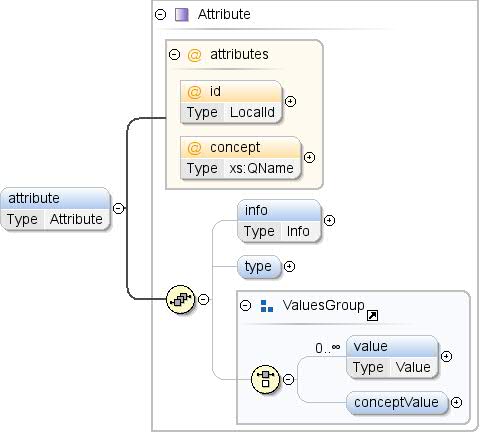 |
| Typ |
Atrybut |
| Właściwości |
| treść: |
Złożone |
| min.: |
0 |
| maxOccurs: |
nieograniczony |
|
| Model |
info{0,1} , type{0,1} , (wartość*
| conceptValue{0,1}) |
| Dzieci |
conceptValue, info, type,
wartość |
| Instancja |
<attribute concept="" id="">
<info>{0,1}</info>
<type format="" ref="">{0,1}</type>
</attribute>
|
| Atrybuty |
| QName |
Typ |
Naprawiono |
Domyślny |
Użyj |
Adnotacja |
| koncepcja |
xs:QName |
|
|
opcjonalnie |
Odniesienie do pojęcia, który odpowiada wartościom.
atrybutu. Jeśli atrybut określa typ, to
musi pasować do typu wskazanej koncepcji. Odwołanie do
koncepcja zewnętrzna musi mieć postać
„prefix:other_koncepcja”, gdzie „prefiks” to
prefiks używany dla przestrzeni nazw zewnętrznego zbioru danych (patrz XML
przestrzeni nazw). |
| id |
LocalId |
|
|
opcjonalnie |
Identyfikator atrybutu koncepcja. Ten identyfikator musi być:
które są unikalne (w odniesieniu do różnych atrybutów i właściwości).
„id” można pominąć, jeśli określono atrybut „koncepcja”. Pod tym kątem
, identyfikator to prostota, którą określa się z wartością lokalną
wymienionego pojęcia. Na przykład <atrybut
concept="unit:currency"/> jest odpowiednikiem funkcji
<attribute id="currency"
concept="unit:currency"/> |
|
| Źródło |
<xs:element name="attribute" type="Attribute" minOccurs="0" maxOccurs="unbounded">
<xs:annotation>
<xs:documentation>Attribute associated with the dataset.</xs:documentation>
</xs:annotation>
</xs:element>
|
Element: dspl / tematy
| Przestrzeń nazw |
http://schemas.google.com/dspl/2010 |
| Adnotacje |
Hierarchia tematów służących do porządkowania zawartości
w gromadzeniu danych. Kolejność, w jakiej są podawane tematy, ma znaczenie i powinna być
które są respektowane przez wizualizacje przedstawiające te tematy. |
| Diagram |
 |
| Właściwości |
|
| Model |
topic+, |
| Dzieci |
temat |
| Instancja |
<topics>
<topic id="" parentTopic="">{1,unbounded}</topic>
</topics>
|
| Źródło |
<xs:element name="topics" minOccurs="0">
<xs:annotation>
<xs:documentation>A hierarchy of topics used to organize the contents of
the dataset. The order in which topics are given is
meaningful and should be respected by visualizations
that displays these topics.</xs:documentation>
</xs:annotation>
<xs:complexType>
<xs:sequence>
<xs:element name="topic" type="Topic" maxOccurs="unbounded"/>
</xs:sequence>
</xs:complexType>
</xs:element>
|
| Przestrzeń nazw |
http://schemas.google.com/dspl/2010 |
| Diagram |
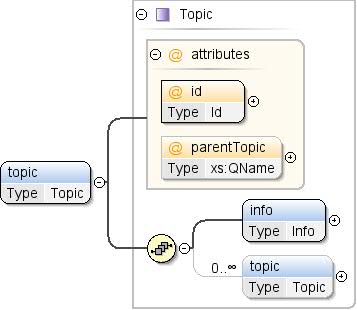 |
| Typ |
Temat, |
| Właściwości |
| treść: |
Złożone |
| maxOccurs: |
nieograniczony |
|
| Model |
info , topic* |
| Dzieci |
info, topic |
| Instancja |
<topic id="" parentTopic="">
<info>{1,1}</info>
<topic id="" parentTopic="">{0,unbounded}</topic>
</topic>
|
| Atrybuty |
| QName |
Typ |
Naprawiono |
Domyślny |
Użyj |
Adnotacja |
| id |
Identyfikator |
|
|
wymagane |
Unikalny identyfikator tematu w parametrze
w gromadzeniu danych. |
| parentTopic |
xs:QName |
|
|
opcjonalnie |
Identyfikator tematu nadrzędnego danego tematu, jeśli taki istnieje.
Nie można określić elementu nadrzędnyTopic w przypadku tematów w treści
na inne tematy. |
|
| Źródło |
<xs:element name="topic" type="Topic" maxOccurs="unbounded"/>
|
Element: dspl / pojęcia
| Przestrzeń nazw |
http://schemas.google.com/dspl/2010 |
| Adnotacje |
Lista pojęć zdefiniowanych w tym zbiorze danych. |
| Diagram |
 |
| Właściwości |
|
| Model |
Concept+ |
| Dzieci |
koncepcja |
| Instancja |
<concepts>
<concept extends="" id="">{1,unbounded}</concept>
</concepts>
|
| Źródło |
<xs:element name="concepts" minOccurs="0">
<xs:annotation>
<xs:documentation>A list of concepts defined in this dataset.</xs:documentation>
</xs:annotation>
<xs:complexType>
<xs:sequence>
<xs:element name="concept" type="Concept" maxOccurs="unbounded"/>
</xs:sequence>
</xs:complexType>
</xs:element>
|
| Przestrzeń nazw |
http://schemas.google.com/dspl/2010 |
| Diagram |
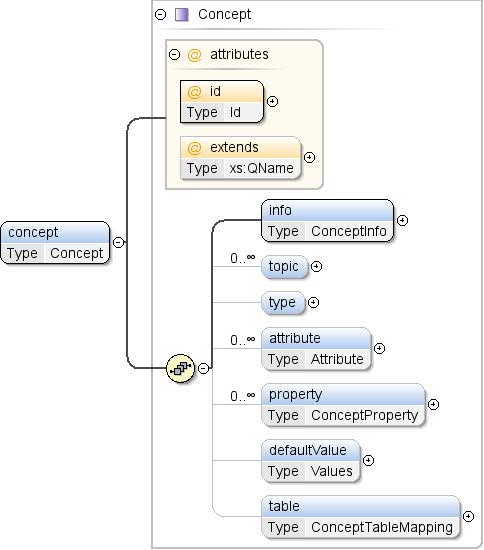 |
| Typ |
Koncepcja |
| Właściwości |
| treść: |
Złożone |
| maxOccurs: |
nieograniczony |
|
| Model |
info , topic* , type{0,1} ,
attribute* , property* , defaultValue{0,1} , table{0,1} |
| Dzieci |
attribute, defaultValue, info,
property, table, topic,
typ |
| Instancja |
<concept extends="" id="">
<info>{1,1}</info>
<topic ref="">{0,unbounded}</topic>
<type ref="">{0,1}</type>
<attribute concept="" id="">{0,unbounded}</attribute>
<property concept="" id="" isMapping="false" isParent="false">{0,unbounded}</property>
<defaultValue>{0,1}</defaultValue>
<table ref="">{0,1}</table>
</concept>
|
| Atrybuty |
| QName |
Typ |
Naprawiono |
Domyślny |
Użyj |
Adnotacja |
| rozszerza |
xs:QName |
|
|
opcjonalnie |
Unikalny identyfikator elementu, do którego odnosi się dana koncepcja
Wspomniane pojęcie może być zdefiniowane w tym samym zbiorze danych
lub zewnętrznie, np. w innym zbiorze danych. Odniesienie do zasobu zewnętrznego
koncepcja musi mieć format „prefix:identyfikator_innego_koncepcji”,
gdzie „prefiks” to prefiks używany dla przestrzeni nazw
w zewnętrznym zbiorze danych (patrz: przestrzenie nazw XML). |
| id |
Identyfikator |
|
|
wymagane |
Unikalny identyfikator koncepcji, którym musi być
unikalne globalnie w obrębie zbioru danych. |
|
| Źródło |
<xs:element name="concept" type="Concept" maxOccurs="unbounded"/>
|
Element: dspl / wycinki
| Przestrzeń nazw |
http://schemas.google.com/dspl/2010 |
| Adnotacje |
Lista wycinków zdefiniowanych w tym zbiorze danych. |
| Diagram |
 |
| Właściwości |
|
| Model |
wycinek+ |
| Dzieci |
wycinek |
| Instancja |
<slices>
<slice id="">{1,unbounded}</slice>
</slices>
|
| Źródło |
<xs:element name="slices" minOccurs="0">
<xs:annotation>
<xs:documentation>A list of slices defined in this dataset.</xs:documentation>
</xs:annotation>
<xs:complexType>
<xs:sequence>
<xs:element name="slice" type="Slice" maxOccurs="unbounded"/>
</xs:sequence>
</xs:complexType>
</xs:element>
|
Element: dspl / slices / wycinek
| Przestrzeń nazw |
http://schemas.google.com/dspl/2010 |
| Diagram |
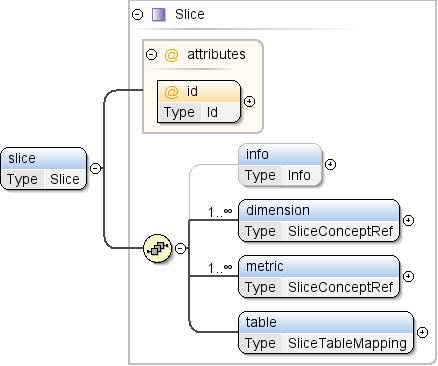 |
| Typ |
Wycinek |
| Właściwości |
| treść: |
Złożone |
| maxOccurs: |
nieograniczony |
|
| Model |
info{0,1} , wymiar+ , dane+
, tabela |
| Dzieci |
wymiar, informacje, dane,
tabela |
| Instancja |
<slice id="">
<info>{0,1}</info>
<dimension concept="">{1,unbounded}</dimension>
<metric concept="">{1,unbounded}</metric>
<table ref="">{1,1}</table>
</slice>
|
| Atrybuty |
| QName |
Typ |
Naprawiono |
Domyślny |
Użyj |
Adnotacja |
| id |
Identyfikator |
|
|
wymagane |
Unikalny identyfikator wycinka. |
|
| Źródło |
<xs:element name="slice" type="Slice" maxOccurs="unbounded"/>
|
Element: dspl / tabele
| Przestrzeń nazw |
http://schemas.google.com/dspl/2010 |
| Adnotacje |
Lista tabel zdefiniowanych w tym zbiorze danych. |
| Diagram |
 |
| Właściwości |
|
| Model |
tabela+ |
| Dzieci |
tabela |
| Instancja |
<tables>
<table id="">{1,unbounded}</table>
</tables>
|
| Źródło |
<xs:element name="tables" minOccurs="0">
<xs:annotation>
<xs:documentation>A list of tables defined in this dataset.</xs:documentation>
</xs:annotation>
<xs:complexType>
<xs:sequence>
<xs:element name="table" type="Table" maxOccurs="unbounded"/>
</xs:sequence>
</xs:complexType>
</xs:element>
|
| Przestrzeń nazw |
http://schemas.google.com/dspl/2010 |
| Diagram |
 |
| Typ |
Tabela |
| Właściwości |
| treść: |
Złożone |
| maxOccurs: |
nieograniczony |
|
| Model |
info{0,1} , column+ , data{0,1} |
| Dzieci |
kolumna, dane, informacje |
| Instancja |
<table id="">
<info>{0,1}</info>
<column format="" id="" type="">{1,unbounded}</column>
<data>{0,1}</data>
</table>
|
| Atrybuty |
| QName |
Typ |
Naprawiono |
Domyślny |
Użyj |
Adnotacja |
| id |
Identyfikator |
|
|
wymagane |
Unikalny identyfikator tabeli w
w gromadzeniu danych. |
|
| Źródło |
<xs:element name="table" type="Table" maxOccurs="unbounded"/>
|
Atrybut: dspl / import / @namespace
| Przestrzeń nazw |
Brak przestrzeni nazw |
| Adnotacje |
Przestrzeń nazw zaimportowanego zbioru danych określona jako identyfikator URI. O
aby można było powiązać prefiks z tą przestrzenią nazw,
wymienionych. Zobacz [Przestrzenie nazw XML], aby dowiedzieć się więcej o użyciu
przestrzeni nazw i prefiksów w pliku XML. |
| Właściwości |
|
| Używane przez |
|
| Źródło |
<xs:attribute name="namespace" use="required">
<xs:annotation>
<xs:documentation>The namespace of the imported dataset, specified as
a URI. A prefix must be associated with this
namespace before its contents can be referenced. See
[XML Namespaces] for more information about the use
of namespaces and prefixes in XML.</xs:documentation>
</xs:annotation>
</xs:attribute>
|
Atrybut: dspl / import / @location
| Przestrzeń nazw |
Brak przestrzeni nazw |
| Adnotacje |
Opcjonalna lokalizacja, w której definicja zaimportowanego pliku
w postaci adresu URL. Jeśli lokalizacja zostanie pominięta, parametr
system przetwarzający ten zbiór danych DSPL musi już znać zaimportowane
w gromadzeniu danych. Uwaga dotycząca implementacji: importer zbioru danych Google ignoruje
lokalizacji. Każdy zaimportowany zbiór danych musi być znany
lub usługi importera. |
| Właściwości |
|
| Używane przez |
|
| Źródło |
<xs:attribute name="location" use="optional">
<xs:annotation>
<xs:documentation>An optional location where the definition of the
imported dataset can be found, specified as a
URL. If the location is omitted, the system
processing this DSPL dataset must already know the
imported dataset.
Implementation note: The Google dataset importer
ignores the location attribute. Any imported dataset
must be known by the Google importer beforehand.</xs:documentation>
</xs:annotation>
</xs:attribute>
|
Atrybut: dspl / @targetNamespace
| Przestrzeń nazw |
Brak przestrzeni nazw |
| Adnotacje |
Każdy zbiór danych może mieć docelową przestrzeń nazw. Wartość docelowa
przestrzeń nazw to identyfikator URI jednoznacznie identyfikujący zbiór danych. Więcej
informacje na temat użycia przestrzeni nazw w kodzie XML znajdziesz tutaj:
http://www.w3.org/TR/REC-xml-names/ Jeśli nie podano targetNamespace,
Gdy zbiór danych będzie
zaimportowane dane. |
| Typ |
xs:anyURI |
| Właściwości |
|
| Używane przez |
|
| Źródło |
<xs:attribute name="targetNamespace" type="xs:anyURI" use="optional">
<xs:annotation>
<xs:documentation>Each dataset may provide a target namespace. The
target namespace is a URI that uniquely identifies the
dataset. For more information about the use of namespaces in XML,
see:
http://www.w3.org/TR/REC-xml-names/
If no targetNamespace is provided, then a namespace will be
generated when the dataset is imported.</xs:documentation>
</xs:annotation>
</xs:attribute>
|
Utworzono za pomocą
oXygen XML Editor.
O ile nie stwierdzono inaczej, treść tej strony jest objęta licencją Creative Commons – uznanie autorstwa 4.0, a fragmenty kodu są dostępne na licencji Apache 2.0. Szczegółowe informacje na ten temat zawierają zasady dotyczące witryny Google Developers. Java jest zastrzeżonym znakiem towarowym firmy Oracle i jej podmiotów stowarzyszonych.
Ostatnia aktualizacja: 2025-07-25 UTC.
[null,null,["Ostatnia aktualizacja: 2025-07-25 UTC."],[],["The DSPL XML schema defines a dataset's structure using key components: `tables`, `concepts`, `slices`, and `topics`. The root `dspl` element encapsulates the dataset, utilizing `import` to reference externals, `info` and `provider` for metadata, `attribute` for dataset attributes, and `topics` to hierarchically organize the concepts. `concepts`, `slices`, `tables` are for concept definition, slice definition, and data table, respectively. Each element like `import`, `info`, `provider`, `attribute`, `topic`, `concept`, `slice`, `table` uses specific attributes and child elements for configuration. Each element has a specific cardinality that is defined in the document.\n"]]












